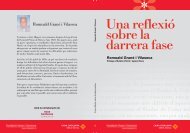El retorn de la llúdriga - Fundació Catalunya - La Pedrera
El retorn de la llúdriga - Fundació Catalunya - La Pedrera
El retorn de la llúdriga - Fundació Catalunya - La Pedrera
Create successful ePaper yourself
Turn your PDF publications into a flip-book with our unique Google optimized e-Paper software.
<strong>La</strong> Jonquera<br />
riu Anyet<br />
Maçanet <strong>de</strong> Cabrenys<br />
riu Arnera<br />
riu Llobregat<br />
d’Empordà<br />
riu Orlina<br />
L<strong>la</strong>nçà<br />
riu Muga<br />
Sant Llorenç <strong>de</strong> <strong>la</strong> Muga<br />
Pera<strong>la</strong>da<br />
riu Llierca<br />
Sant Pau <strong>de</strong> Seguries<br />
Castellfollit<br />
<strong>de</strong> <strong>la</strong> Roca<br />
riera <strong>de</strong> Bianya<br />
riu Junyell<br />
Olot<br />
Santa Pau<br />
Besalú<br />
riu Ser<br />
Castelló<br />
riera <strong>de</strong> Figueres<br />
d’Empúries Roses<br />
riu Manol<br />
Figueres rec Parc Natural<br />
Navata<br />
Corredor<br />
riera<br />
<strong>de</strong>ls Aiguamolls<br />
d’Àlguema<br />
<strong>de</strong> l’Empordà<br />
rec Sirvent<br />
riu Fluvià<br />
Sant Pere Pescador badia<br />
Bàscara<br />
riu Vell <strong>de</strong> Roses<br />
L’Esca<strong>la</strong><br />
Banyoles<br />
Amer<br />
Sarrià <strong>de</strong> Ter<br />
ce<strong>de</strong>nt <strong>de</strong> Nordamèrica, ha colonitzat les conques <strong>de</strong>ls rius Muga i Fluvià<br />
recentment, a partir <strong>de</strong> pob<strong>la</strong>cions veïnes.<br />
<strong>La</strong> Muga irriga una important zona agríco<strong>la</strong>, però només alguns trams<br />
<strong>de</strong>l curs mig i baix reben aigües residuals urbanes tracta<strong>de</strong>s (bàsicament <strong>de</strong><br />
<strong>la</strong> ciutat <strong>de</strong> Figueres). <strong>El</strong> Fluvià creua una important àrea industrial (al voltant<br />
d’Olot) al seu curs alt, i travessa zones predominantment agrícoles fins<br />
a <strong>la</strong> <strong>de</strong>sembocadura.<br />
2.2. Situació <strong>de</strong> <strong>la</strong> <strong>llúdriga</strong> a l’inici <strong>de</strong>l projecte<br />
Com ja s’ha esmentat, quan es p<strong>la</strong>nteja el <strong>retorn</strong> <strong>de</strong> <strong>la</strong> <strong>llúdriga</strong> a començaments<br />
<strong>de</strong>ls 1990s, l’espècie està completament extingida a l’àrea d’estudi.<br />
Però val <strong>la</strong> pena repassar <strong>la</strong> cronologia <strong>de</strong> <strong>la</strong> seva <strong>de</strong>saparició.<br />
Fins a mitjans <strong>de</strong>l segle XX, les llúdrigues habitaven gairebé tots els racons<br />
<strong>de</strong>ls rius, rieres i aiguamolls <strong>de</strong> les conques <strong>de</strong> <strong>la</strong> Muga i <strong>de</strong>l Fluvià. A partir<br />
d’aquest moment, <strong>de</strong>gut als factors ja explicats, <strong>la</strong> pob<strong>la</strong>ció va començar<br />
a disminuir, fins a <strong>de</strong>saparèixer completament a <strong>la</strong> dècada <strong>de</strong>ls 1980s.<br />
De <strong>la</strong> bibliografia disponible i mitjançant enquestes a naturalistes, caçadors,<br />
pescadors i pagesos, va ser possible reconstruir l’evolució <strong>de</strong> <strong>la</strong> pob<strong>la</strong>ció<br />
<strong>de</strong> llúdrigues <strong>de</strong> <strong>la</strong> zona <strong>de</strong>s <strong>de</strong>ls 1950s fins els 1980s, quan es va produir<br />
l’extinció.<br />
A <strong>la</strong> dècada <strong>de</strong>ls 1950s, es podien trobar llúdrigues a gairebé tots els rius<br />
i rierols <strong>de</strong> les dues conques, així com a quasi tots els recs, l<strong>la</strong>cunes i<br />
estanys <strong>de</strong>ls Aiguamolls <strong>de</strong> l’Empordà. Són <strong>de</strong> particu<strong>la</strong>r interès les referències<br />
a llúdrigues habitant a petits rierols <strong>de</strong> muntanya amb poca aigua, que<br />
podria indicar que els trams “millors” <strong>de</strong>vien gaudir <strong>de</strong> <strong>de</strong>nsitats més altes<br />
d’individus. Es caçaven moltes llúdrigues, emprant armes <strong>de</strong> foc, paranys<br />
i, fins i tot, forques. Una observació al Cap Norfeu (Cap <strong>de</strong> Creus) podria<br />
indicar que, fins i tot, alguns individus vivien a <strong>la</strong> costa.<br />
Durant <strong>la</strong> dècada <strong>de</strong>ls 1960s <strong>la</strong> <strong>llúdriga</strong> encara era abundant, però les<br />
informacions aporta<strong>de</strong>s semblen indicar que es mataven menys individus,<br />
el que podria ésser causat per una reducció en <strong>la</strong> pob<strong>la</strong>ció. Les cites proce<strong>de</strong>nts<br />
<strong>de</strong> <strong>la</strong> serra <strong>de</strong> l’Albera disminueixen, però als Aiguamolls <strong>de</strong> l’Empordà<br />
les llúdrigues encara són molt comunes, per exemple als arrossars.<br />
riu Ter<br />
Girona<br />
Celrà<br />
F<strong>la</strong>çà<br />
Torroel<strong>la</strong><br />
<strong>de</strong> Montgrí<br />
<strong>El</strong> <strong>retorn</strong> <strong>de</strong> <strong>la</strong> <strong>llúdriga</strong> 19<br />
Figura 2.2.<br />
Àrea geogràfica<br />
<strong>de</strong> <strong>la</strong> reintroducció.<br />
<strong>La</strong> línea vermel<strong>la</strong><br />
representa el límit<br />
<strong>de</strong> <strong>la</strong> conca fluvial.




